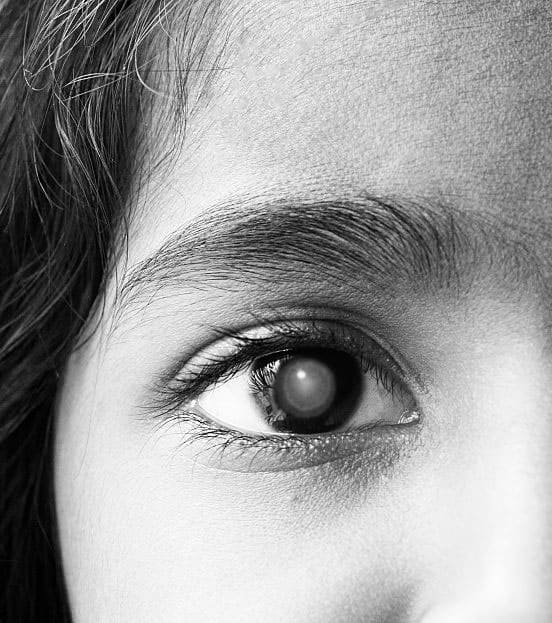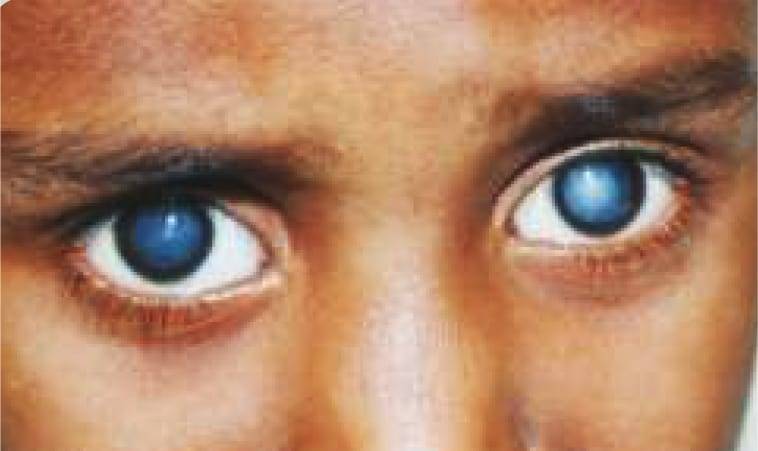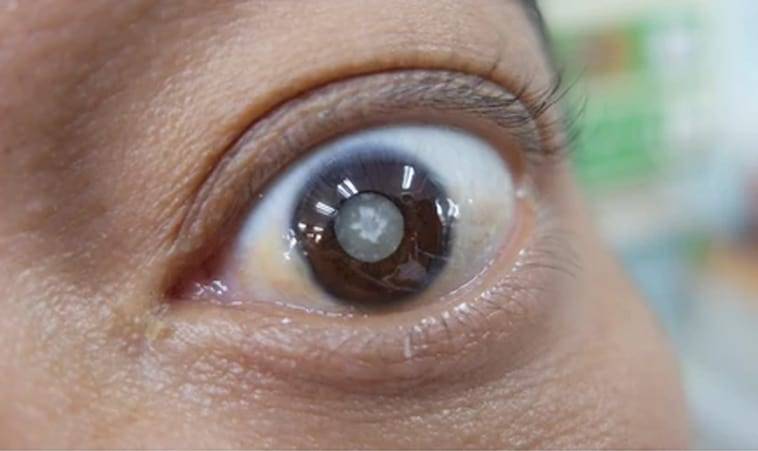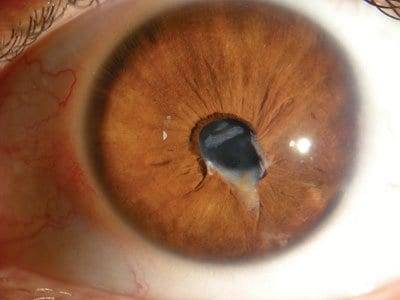Childhood cataracts are responsible for 12.5% to 42.9% of childhood blindness in India.
A cataract is a clouding of the lens in the eye, which can affect vision. Cataract can occur in either or both eyes, but it cannot spread from one eye to the other. It is a general belief that only adults suffer from cataract. But children can be affected by cataract too and it can lead to amblyopia or permanent blindness if not treated in time. A study conducted by Narayana Nethralaya in 2 taluks near Bangalore, showed prevalence of childhood cataracts to be 6/10,000 children.
Pediatric Cataract

Symptoms of Cataract in a child
Poor vision – which may manifest in very subtle ways – when a child does not look at and play with toys, responds more to sound rather than vision or when a child does not move independently
White reflex in the center of the eye – Normally the center appears black but with cataract, the center may appear grey or white.
Squinting or crossing of eyes
Rapid uncontrolled eye movements also called nystagmus may be a sign of poor vision and is especially seen when child is affected by cataract in both eyes early in life
Types of Cataract in children

Childhood Cataract
Some babies are born with cataracts (called as congenital cataract) or develop them in childhood (developmental cataract), often in both eyes. These cataracts may be so small that they do not affect vision. If they do, they may need to be removed.

Secondary Cataract
Cataracts also can develop in children who have other health problems, such as rubella, diabetes, etc. It could also occur with ocular problems like microphthalmos (small eye), etc.

Traumatic Cataract
Cataracts can develop after an eye injury, sometimes years later.
Causes of Cataract in children
Any disruption of the normal structure of the lens can result in clouding. This could be either caused by:
- Accumulation of abnormal breakdown products (metabolites) with retention of water within the lens or
- Interruption of normal development of the lens by a genetic error or following infection with viruses, radiation and drugs.
In our country infection of pregnant ladies with Rubella virus & consanguineous marriages (marriages within relatives) are the most common causes. The chances of having congenital cataract are particularly high if there is a family history of cataract.

Treatment of Cataract in Children
The aim of the treatment or surgery is to remove the cloudy lens and clear the visual axis (the central part of the eye) so that the light rays can easily enter the eye and produce a crisp image on the retina. Intraocular lenses are becoming more common in children. Putting an intraocular or artificial lens will depend on the age of the child, status of the eye, presence of any ocular problem.
However, they cannot be implanted in very young children, as the eyeball is small in size and still growing. Even if the lens is not put at the time of the cataract surgery, it can definitely be considered as an option when the child grows older. The surgery is performed under general anesthesia. To serve the purpose of improving vision of the child, optical correction with a contact lens and/or glasses is necessary.
Cataract surgery in a child is technically more difficult than in an adult & should be performed only by a surgeon with adequate experience in pediatric cataract surgeries. If surgery to only one eye is required, the issue of amblyopia therapy becomes very important for the final visual outcome.

FAQ
Frequently Asked Questions
How do I know that my child has Cataract?
As cataract is an opacification of the lens, there is a white reflex seen in the centre that is in the pupillary region. This could be either seen by the pediatrician or child’s parents. Infact this reflex may also be picked up in photographs. The absence of an eye contact is an important sign that should alarm the parents. If the child does not respond to visual stimuli like picking up objects, or recognizing faces or has constantly wandering or moving eyeballs after first 2-3 months, the parents should immediately consult a pediatric ophthalmologist.
How can Cataract affect my child's vision?
In the case of a newborn infant, a cataract causes the immature visual system to be deprived of the stimulation needed for normal development of vision. If left untreated, permanent visual loss (lazy eye) may occur.
What are the effects of Cataract?
If the cataract is small, there may be only slight blurring of vision with near normal visual development. Frequently, though, the impairment is more severe and can lead to permanent amblyopia (lazy eye). Without adequate stimulation central vision can be permanently impaired. Some peripheral vision usually remains and the eye does not usually lose the ability to distinguish light and dark. Congenital cataracts can affect one eye only or both eyes. In bilateral cases the cataract can be denser in one eye than other.
Is cataract surgery in children different from that in adults?
Cataract surgery involves removal of cloudy lens and when possible implantation of an artificial lens, in certain conditions an artificial lens may not be implanted – in children less than 1 year of age, when the eyes are too small, when the lens bag is weak or in cataract due to trauma.
Children are prone to develop an after cataract which is formation of white membrane behind the artificial lens. Hence, in very young children an additional procedure called capsulotomy and or vitrectomy may be done to minimize this risk. Hence cataract in children is different from that done in adults
What is the ideal time for performing cataract surgery?
Because a clear visual axis is essential for early visual development, a diagnosis within the first few weeks of life is important. Surgery has to be done as early as possible to improve the chances of maximum visual recovery. It can be done as early as 2 days after birth provided there is no risk for general anesthesia due to systemic problems.
Is surgery the end of all the problems?
No. Though surgery does clear the visual axis, the child may develop lazy eye, misalignment of eyes, shaking of eyes (nystagmus), development of refractive errors, and late complications of surgery. However, with newer surgical techniques, the incidence of these complications has significantly dropped. Lazy eye (amblyopia) may be seen in one or both eyes and would require treatment for the same depending on the case like patching, eye drop instillation and even vision stimulation exercises. Misalignment of eyes may require surgical intervention later in life. Late complications of surgery that can occur include membrane formation in pupillary axis, increase in intraocular pressures (glaucoma) with subsequent optic nerve damage and retinal detachment. Hence, following surgery, monitoring of the vision, refractive error,
development of complications etc. is mandatory and repeated follow-ups are warranted in an attempt to achieve good visual rehabilitation. In short, it is not the end but the beginning, requiring a long association
between the pediatric ophthalmologist and the child along with the parents.
What is the final prognosis for childhood cataracts?
The eventual outcome is very much dependent on the type of cataract, age of the child & the timing of surgery. Since timely management results in significant visual improvement and hence a near normal child, it is important that the parents should be highly motivated and act fast. The important point to remember is that early diagnosis & treatment is the key to successful visual rehabilitation in childhood cataracts.
What happens if cataract surgery is delayed in children?
If timely treatment is not done, children may develop dense amblyopia or lazy eye which is irreversible or only partially reversible and thus the child may become visually impaired for life. Hence it is imperative that childhood cataract be treated as early as possible. So when it comes to treatment of childhood cataract – CATCH THEM EARLY, CATCH THEM RIGHT, SO EVERY CHILD CAN HAVE THE BEST EYESIGHT
